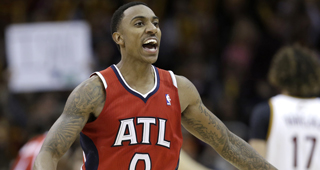After failing to pull away from the Atlanta Hawks in the first half on Saturday night, the Indiana Pacers laid an egg fitting for Easter weekend in the third quarter of their playoff opener. The Hawks cruised to a 101-93 win at Bankers Life Fieldhouse to take a 1-0 lead in the best-of-seven series.
The Pacers raced out to the NBA’s best record ahead of the All-Star break on the strength on dominant second-half runs. After struggling as the regular season wound down, barely holding onto the top seed in the Eastern Conference, the Pacers allowed the eighth-seeded Hawks to steal home court advantage without much difficulty.
Atlanta took control of the game in the third and didn’t let go. The only one of the sixteen playoff teams with a losing record, they hung 30 points on the top-rated defense in the regular season -- Indiana allowed just 99.3 points per 100 possessions. Led by Jeff Teague, who had a playoff career-high 28 points, the Hawks shot 50% from the field in the quarter, went 9-for-10 from the foul line and committed just two turnovers.
The issues for the Pacers were two-fold. They couldn’t stop the Hawks and their offense wasn’t nearly efficient enough to keep them in the game. While the Pacers worked to scrap together points, Teague and Paul Millsap combined for 27 points on 15 shots in the decisive quarter.
Indiana went 5-for-19 in the third and turned the ball over five times. Paul George, an early-season MVP candidate, couldn’t get anything to fall as the game tilted towards the road team. George went 1-for-7 from the floor, including 1-for-4 from three.
Hawks From Deep
It was well documented heading into the series that the Hawks would lean heavily on the three ball. Only the Houston Rockets attempted more three-pointers per game than Atlanta (25.8), who ranked 13th in percentage (.363).
The Pacers defend the perimeter well, when on their game, running opponents off the line -- teams averaged just 19 threes per game against Indy. They held opponents to 34.5% from deep, the fourth-lowest percentage in the NBA.
Atlanta hoisted 30 three-pointers in Game 1, a high rate, but they weren’t overly efficient. They hit 11, shooting 36.7%, which is right around where you’d expect given their performance during the season. Instead, the Hawks pounded the bigger Pacers in the paint, going 24-for-29 from the line. They averaged fewer than 22 free throw attempts during the regular season.
Hometown Heroes
In a battle of Indianapolis point guards, Jeff Teague dominated George Hill.
Teague’s career night was highlighted by 10 trips to the line. Hill and the Pacers’ other guards couldn’t keep up with Teague’s speed or his shifty moves, resulting in desperate fouls simply to avoid getting burned.
Remember the 2011 playoffs when a young George shadowed Derrick Rose? Frank Vogel should consider a scheme where George is the primary defender on Teague, especially since Hill and Lance Stephenson are capable of hanging with Kyle Korver, DeMarre Carroll and Lou Williams.
It couldn’t hurt as the Hawks are most efficient offensively when Teague is in control and his teammates are taking advantage of a defense that has been stretched out.
On The Boards
The Pacers have a size advantage, as they do against most teams, but it wasn’t on full display Saturday night. They had a +4 rebounding differential in Game 1, but the gap will have to be bigger if they are going to win two of the next three games to earn back home court.
Atlanta had the fourth-lowest rebounding percentage in the NBA, while Indiana had the third-highest percentage.
The Hawks’ frontcourt trio of Carroll, Millsap and Pero Antic grabbed 25 rebounds in 48 chances (data from NBA.com). George, David West and Roy Hibbert corralled 21 of 35 potential boards. Indiana had some defensive switch issues that kept players out of rebounding position, which is one of the reasons the frontcourt had so many fewer chances. On the bright side, they had a promising advantage in percentage of rebounds grabbed (60% to 52%).
It doesn’t help that the Hawks attempt so many threes. The long rebounds are far less predictable and there were at least a handful of times in this game when the ball simply bounced over a few jumping Pacers back to the Hawks.
Body Language
For the first two minutes, the Pacers brought the fight to the Hawks. Over the remaining 46 minutes, Indiana waited for the game to turn in their favor instead of going out and grabbing hold of the momentum.
In a disturbing trend, the body language was terrible as adversity piled up. They closed out the season with a strong final week after a disappointing loss to the Miami Heat, seemingly righting the ship enough to continue sorting out their issues while dispatching of the Hawks.
It was clear just a few seconds into the second half that they haven’t gotten rid of enough bad habits to look past a team that only made the playoffs because the New York Knicks dug themselves too big of a hole to overcome in the final month of the season. The Pacers entered the season with title aspirations. The Hawks entered it thinking about the lottery.
In a vacuum, you’d have guessed the reverse when watching Game 1.



